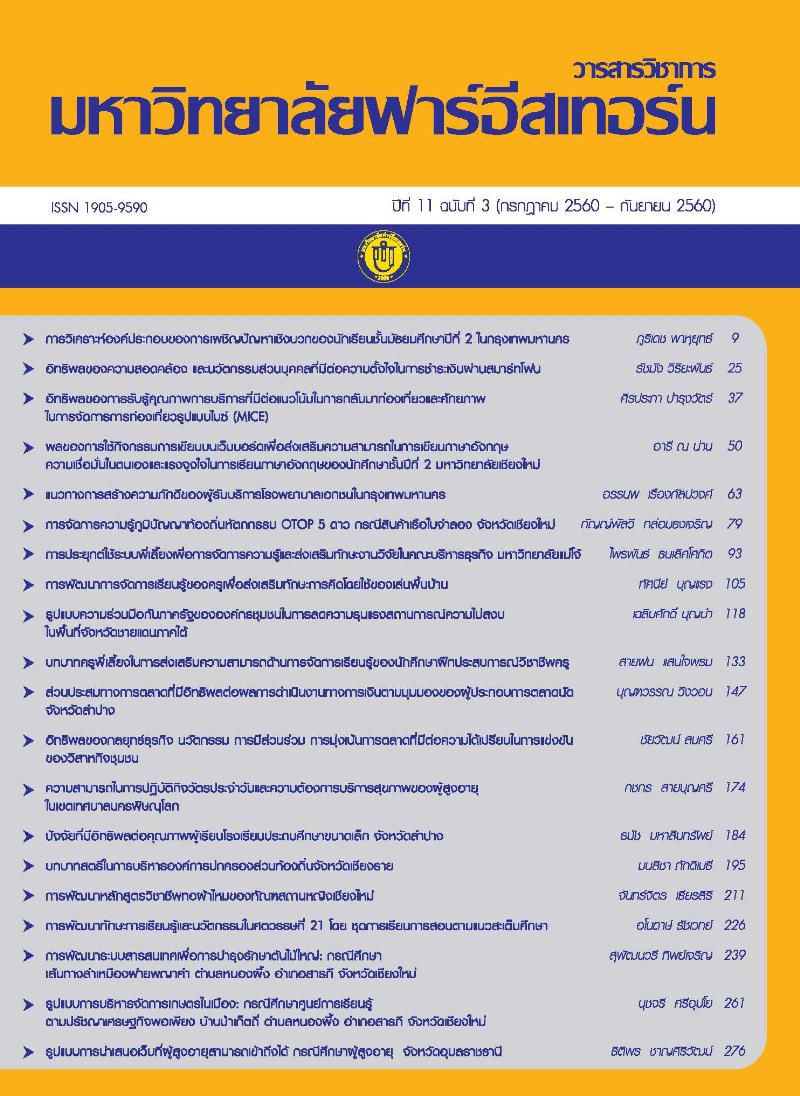การพัฒนาทักษะการเรียนรู้และนวัตกรรมในศตวรรษที่ 21 โดยชุดการเรียนการสอนตามแนวสะเต็มศึกษา เรื่อง การแยกสาร ของนักเรียนชั้นมัธยมศึกษาชั้นปีที่ 2
Main Article Content
Abstract
จากการวิจัยครั้งนี้มีวัตถุประสงค์ 1) เพื่อศึกษาหาประสิทธิภาพของชุดการเรียนการสอนตาม
แนวสะเต็มศึกษา เรอื่ ง การแยกสาร 2) เพอื่ ศึกษาผลสัมฤทธทิ์ างการเรียนในรายวิชาวิทยาศาสตร ์ เรอื่ ง การแยกสาร
3) เพอื่ ศึกษาทักษะการเรียนรูแ้ ละนวัตกรรมของผูเ้ รียน โดยกลุม่ ตัวอยา่ งทใี่ ช ้ คือ นกั เรียนระดับชนั้ มัธยมศึกษา
ปีที่ 2 ปีการศึกษา 2558 โรงเรียนสันทรายหลวง อำเภอสันทราย จังหวัดเชียงใหม่ สำนักงานเขตพื้นที่
การศึกษาเชียงใหม ่ เขต 2 จาํ นวน 1 หอ้ งละ 22 คน โดยไดจ้ ากการเลือกแบบสุม่ อยา่ งงา่ ย จากผลจากการวิจยั
พบว่า 1) ชุดการเรียนการสอนตามแนวสะเต็มศึกษา เรื่อง การแยกสาร ที่สร้างขึ้นนั้น มีค่าประสิทธิภาพของ
ชุดการเรียนการสอนที่ผ่านการประเมินโดยผู้เชี่ยวชาญ และทดสอบประสิทธิภาพกับนักเรียนกลุ่มตัวอย่างมี
คา่ เทา่ กับ 77/76 สงู กวา่ ทตี่ งั้ ไวค้ อื 75/75 2) เมอื่ ใชช้ ดุ การเรียนการสอนตามแนวสะเต็มศึกษา เรอื่ ง การแยกสาร
พบว่า ในแผนการจัดการเรียนรู้ที่ 1 - 7 เป็นการให้ความรู้ทางด้านการแยกสาร (วิทยาศาสตร์) ส่วนการจัด
กิจกรรมของแผนการจัดการเรียนรู้ที่ 8 เรื่อง มาแยกสารกันเถอะ เป็นการประมวลความรู้ของนักเรียน
โดยกำหนดสถานการณ์ว่า ให้นักเรียนทำการทดลองแยกสาร โดยมีการออกแบบการทดลอง (วิศวกรรมศาสตร์)
ให้นักเรียนตัดสินใจที่จะใช้อุปกรณ์ที่จำเป็นต้องใช้ในการแยกสาร ในราคาที่กำหนดโดยผู้วิจัย (คณิตศาสตร์)
และการปรับปรุงนวัตกรรมที่นักเรียนสร้างขึ้น (เทคโนโลยี) พบว่า นักเรียนมีการพัฒนาผลสัมฤทธิ์ทางการเรียน
หลังเรียนสูงกว่าก่อนเรียนด้วยคะแนนร้อยละ 2 ที่ระดับนัยสำคัญ 0.05 3) นักเรียนมีทักษะการเรียนรู้และ
นวัตกรรม โดยประเมินพฤติกรรมออกเป็น 3 ด้านดังนี้ 1) การคิดเชิงวิพากษ์และการแก้ปัญหา 2) การสื่อสาร
และการมีส่วนร่วม และ 3) ความคิดสร้างสรรค์และนวัตกรรม โดยเฉลี่ยมีค่าเท่ากับ 3.62 ซึ่งอยู่ในระดับมาก
The objectives of this research were 1) to study effectiveness of learning activity packages
with entitled “Separation of matters”, and 2) to study the academic achievement of students, in
science subject with entitled “Separation of matters”. 3) to study Learning and Innovations skills of
students. 22 students, in 1 classroom, who were in Matthayomsuksa II in Sun-Sai Luang School, in
the County Office of Education District 2 area, Chiang mai province was a sample group, in the
2015 academic year, with a group random sampling technique. The research findings found that
1) the learning activity packages which constructed had the effectiveness, evaluated by the experts
and using with the target group, had value of 77.00/76.00 that higher than the preset (75/75). 2)
After using the learning activity packages (8 lesson plans, 10 hours) found that, in the lesson plans
no. 1 - 7 were the knowledge about separation of matter (Science). In lesson plan no. 8 with entitled
“Let’s separation the matter” that the activity about comprehensive in all learnings. The researcher
had determined the situation for students to design in separation the matter with experiment
(Engineering process). In the same time, the students could make a decision making in choosing
the apparatus with the price that specify already by the researcher (Mathematics). Finally, the
improving processes for the students’ innovations (Technology). The academic achievement, of
the students, had the development in the post-instruction score more than in the pre-instruction
score 2% with .05 level of different statistical significant. 3) The learning and the innovation skills of
students, by evaluating in 3 aspects, Critical thinking and problem solving skills, Communication
and participation skills and creativity and innovation skills, was in the average value of 3.62 which
in the high level.
Article Details
1. Any views and comments in the Journal of Social Innovation and Lifelong Learning are the authors’ views. The editorial staff have not to agree with those views and it is not considered as the editorial’s responsibility.
2. The responsibility of content and draft check of each article belongs to each author. In case, there is any lawsuit about copyright infringement. It is considered as the authors’ sole responsibility.
3. The article copyright belonging to the authors and The Far Eastern University are copyrighted legally. Republication must be received direct permission from the authors and The Far Eastern University in written form.
References
-เกศินี อินถา ภาณุพัฒน์ ชัยวร และ อโนดาษ์ รัชเวทย์. (2558). การสร้างชุดกิจกรรมการเรียนรู้เรื่อง
“มหัศจรรย์ยางพารา” โดยใช้แนวการสอนแบบ STEM กับการพัฒนาการศึกษาใน
ศตวรรษที่ 21 ของนักเรียนระดับชั้นมัธยมศึกษาตอนปลาย. การประชุมวิชาการ“พิบูล
สงครามวิจัย” พ.ศ. 2558. สองทศวรรษ ราชภัฏพิบูลสงคราม จากท้องถิ่นสู่อาเซียน” ณ
ศูนย์วัฒนธรรมภาคเหนือตอนล่าง มหาวิทยาลัยราชภัฏพิบูลสงคราม (ส่วนวังจันทน์)
จังหวัดพิษณุโลก. 13-14 กุมภาพันธ์ 2558
-กรมวิชาการ. (2546). การจัดสาระการเรียนสังคมศึกษา ศาสนาและวัฒนธรรม กลุ่มสาระการเรียนรู้สังคมศึกษา ศาสนา และวัฒนธรรม. กรุงเทพฯ: องค์การรับส่งสินค้าและพัสดุภัณฑ์ (ร.ส.พ.).
-ขวัญทิวา ตั้งมั่น, ปรางวลัย จําปาลี, อภิชาต อุนัยบรรณ และ วินัย ทองมาก. (2555). อุปกรณ์กําจัดวัชพืชอนุรักษ์ (The Equipment Eradicates the Weed). โรงเรียนภูมิซรอลวิทยา จังหวัดศรีสะเกษ. โครงการยุวชนไทยรวมใจรักษ์นํ้า ปี 2555.
-นิรมิษ เพียรประเสริฐ. (2556). เรียนรู้แบบ STEM ผ่าน”หุ่นยนต์” สร้างการมีส่วนร่วมของนักเรียน.สสวท. 42(185). 30-31
-บุญชม ศรีสะอาด, นิภา ศรีไพโรจน์ และนุชวนา ทองทวี. (2528) การวัดผลและประเมินผลทางการศึกษา. มหาสารคาม : ปรีดาการพิมพ์,
-ปัณญานัตย์ วิเศษสมวงศ์. (2558) ส่วนอาเซียนสำนักการประชาสัมพันธ์ต่างประเทศจากบทความออนไลน์.[ออนไลน์].เข้าถึงได้จากhttp://www.aseanthai.net/special-news- detail.php?id=127.(วันที่สืบค้น26 กุมภาพันธ์ 2558)
-พิชญ์สินี ชุมภูคำ. (2558). เอกสารประกอบการอบรมนักศึกษาฝึกประสบการณ์วิชาชีพครูเรื่องการวิจัยในชั้นเรียน. คณะวิทยาศาสตร์และเทคโนโลยี มหาวิทยาลักราชภัฏเชียงใหม่. หน้า 74-75, 80-81
-ล้วน สายยศ และอังคณา สายยศ. (2548). เทคนิคการวิจัยทางการศึกษา. (พิมพ์ครั้งที่ 9). กรุงเทพฯ:สุวีริยาสาส์น
-สถาบันทดสอบทางการศึกษาแห่งชาติ. (2556). คู่มือการจัดสอบO-NET. สำหรับศูนย์สอบ 2556.
-วีระศักดิ์ ชมพูคำ.(2551). วิธีสอนเคมี. สาขาวิชาหลักสูตรและการสอน คณะครุศาสตร์ มหาวิทยาลัยราชภัฏเชียงใหม่.หน้า 422-423.
-ศานิกานต์ เสนีวงศ์. (2556). การจัดกิจกรรมสะเต็มศึกษาด้วยกบโอริงามิ. สสวท. 42 (185). 30-31หนังสือเรียนวิทยาศาสตร์ชั้นมัธยมศึกษาปีที่ 2. (2551). เรื่อง การแยกสาร. สสวท.
-อุปการ จีระพันธุ. (2556). การจัดกิจกรรมสะเต็มศึกษาเรื่องกระติ๊บข้าว. สสวท. 42(185). 36
-Kasama Ratchakit. (2555). ตัวชี้วัด.[ออนไลน์]. เข้าถึงได้จาก http://jane-kasama-10.blogspot.com/ (วันที่สืบค้น 28 กุมภาพันธ์ 2558)
-Becker, Henry K. and Park Kyungsuk. (2011). Effects on Integrative Approached among Science, Technology. Engineering, and Mathematics (STEM) Subject on Student’Learning: A Preliminary Meta- Analysis. Journal of STEM Education, 23 – 37.
-Ning Fang. (2013). Increasing High School Students’ Interest in STEM Education Through Collaborative Brainstorming with yo-yos. Journal of STEM Education, 8 – 14.
-Talley, Terry. (2012). STEM Strategies: Project Based Learning in Earth/Space Systems.Retrieved December 13, 2013, from http: // www. utmb.edu/tstem/ articles/STEMStrategies_PBLand%20Earth_Space_Systems_Final.pdf.
-PSRATI. (2556). ทำไมต้องเป็นการเรียนรู้แบบ Stem Education. [ออนไลน์]. เข้าถึงได้จาก https://lekratiporn.wordpress.com/2013/08/04/stem-education/. (วันที่สืบค้น 26 กุมภาพันธ์ 2558)
-National Research Council. (2012). Education for Life and Work: Developing Transferable Knowledge and Skills in the 21st Century. Washington, DC: The National Academies Press.

